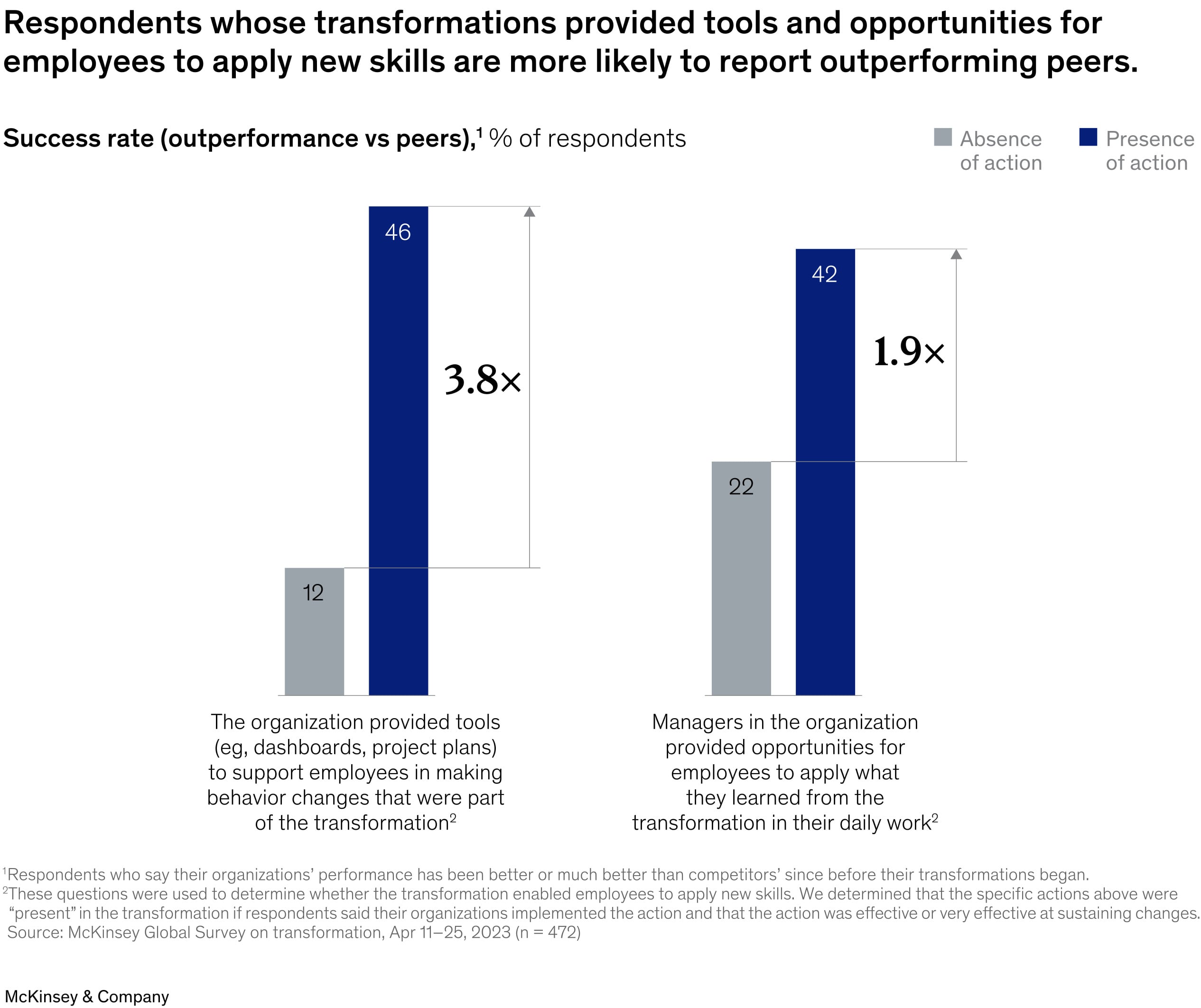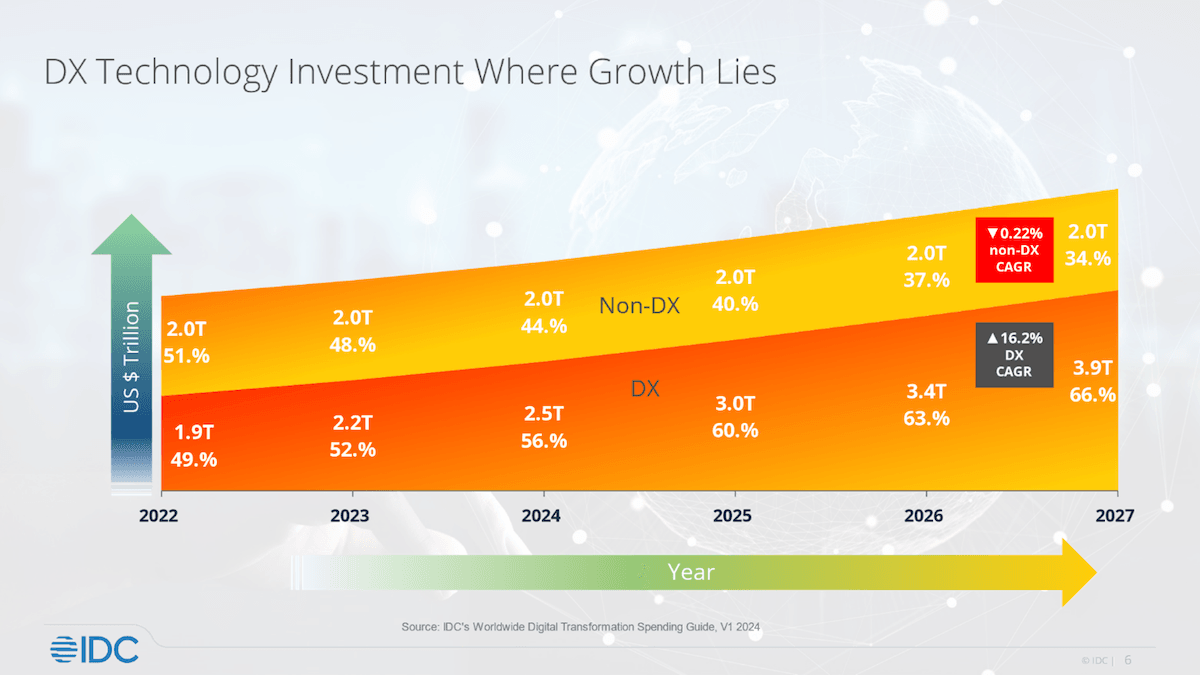Updated: November 13, 2024- 19 min read
Digital transformation is a critical change in how your organization operates, integrating cutting-edge digital tools and technologies to revolutionize your business practices.
However, even with the most progressive strategies, the real challenge lies in execution. This is where you should integrate a digital transformation roadmap to turn ambitious goals into tangible digital outcomes.
Think of enterprise digital transformation not as discarding your legacy systems and practices but as realigning and enhancing them with digital solutions. It's about leveraging your existing resources and strategically positioning your organization to extract maximum value in a digital-centric market.
The cornerstone of this transition? A well-crafted digital transformation roadmap. In this article, we’ll cover how to create a digital transformation roadmap and potential pitfalls to avoid.
Here are some of the key takeaways from this article:
Digital transformation roadmaps are key to transition into digital-centric business models.
Leadership engagement, feedback mechanisms, the right technology stack, and targeted digital initiatives are a MUST for successful transformation.
Having a clear, actionable roadmap is imperative to avoid common pitfalls and ensure effective implementation.
Healthcare Industry Report
Dive into the latest research about digital transformation in healthcare in this white paper from Product School. Spark ideas with 6 case studies and over 25 digital solutions from operations to pharmaceuticals to primary care and more.
Download report
What Is a Digital Transformation Roadmap?
A digital transformation roadmap is a detailed, tactical plan that bridges the gap between your long-term digital aspirations and the concrete steps needed to achieve them.
This roadmap visualizes your journey, breaking down complex strategies into actionable tasks and timelines.
Digital transformation roadmap vs. digital transformation strategy
A digital transformation strategy outlines why and how your organization will undertake digital changes. It provides a long-term vision, focusing on the overall objectives and the guiding principles for integrating digital technologies. The strategy addresses why digital transformation is essential for growth—such as improving efficiency, driving innovation, or enhancing customer experiences—and explains how the organization will align resources, culture, and capabilities to achieve these objectives.
On the other hand, a digital transformation roadmap focuses on the what and when of execution. It breaks down the strategy into specific, actionable tasks with clear timelines and milestones. The roadmap serves as a project plan detailing the technologies to be implemented, the departments involved, and the phases of deployment. It ensures that the strategic vision is translated into concrete actions, setting deadlines and allocating resources effectively.
For example, while a strategy may define the need for using AI to improve customer service (the why and how), the roadmap will outline which specific AI tools will be deployed, when pilot tests will begin, and what resources are needed to achieve the desired outcomes.
Together, the strategy provides direction, and the roadmap ensures a structured, actionable approach to achieving your DX objectives.
5 Pillars of Digital Transformation
Let’s explore the fundamental elements of successful transformations that are vital for the execution of your DX plan:

1. Enhancing customer experience through digital products and services
Embrace technology not just as a tool but as a driver of enriched customer experiences. Today’s consumers seek more than just competitive pricing; they desire a connection with their favorite brands.
Recent insights from PwC’s 2023 Global Consumer Insights Pulse Survey indicate a growing trend of consumers buying directly from brand websites. This shift underscores the need for technology that fosters deeper customer engagement, promising long-term benefits for your business.
2. Leveraging data and analytics for insightful decision-making
In this digital era, data is abundant, but the real power lies in interpreting and applying this data effectively. Data analytics plays a critical role in deciphering past trends and in forecasting future patterns.
This strategic use of data can personalize customer experiences, boosting satisfaction and loyalty. As a Product Leader, harnessing the power of data analytics can transform your decision-making process, whether it’s strategizing at a high level or implementing tactical initiatives.
3. Streamlining operations with process automation
The goal of process automation is to elevate human potential, not replace it. Your teams can focus on more strategic and impactful work by automating routine tasks.
This shift drives operational efficiency and opens avenues for scalability and growth. Integrating process automation into your strategy can help you unlock new potential and drive innovation within your organization.
4. A culture of innovation
One of the major hurdles in digital transformation is ensuring effective collaboration across different departments and teams. Without this collaboration, digital initiatives can falter. In fact, a 2023 KPMG Technology Survey found that 47% of technology executives cite collaboration breakdown as a primary reason for transformation failure, while 40% point to a risk-averse culture as another major obstacle.
5. Strategic direction
One thing that successful enterprise digital transformations have in common is that they are all guided by a clear, forward-thinking strategy. The strategy sets the ultimate goals and provides the resources needed to keep the transformation growing in the right direction.
The strategy is often based on a digital transformation framework that breaks down the necessary steps into a clear action plan according to cohesive principles. This is where the digital transformation roadmap comes in! The DX roadmap serves as a single source of truth that shows how and when different innovations will come to fruition. It increases efficiency by identifying potential roadblocks and dependencies ahead of time.
Creating a Digital Transformation Roadmap
Despite global spending on digital transformation expected to hit $3.4 trillion by 2026, only 16% of organizations report successful implementation. This stark contrast highlights a common pitfall – the absence of an effective digital transformation roadmap and the necessary tools to sustain momentum across the organization.
Digital transformation reshapes everything from how you engage with customers to how you conduct internal processes. But to transition to this framework, you need more than just ambition and money to throw at the problem; you need a clear direction.
This is where your digital transformation roadmap becomes invaluable. It provides a structured pathway to align your strategic vision with actionable goals, ensuring your transformation efforts are both focused and measurable.

Here's a step-by-step guide to help you create an effective digital transformation roadmap:
Step 1: Assessment
Before embarking on any digital transformation journey, it’s critical to have a deep understanding of where your organization currently stands. As discussed above, digital transformation is a holistic process that takes into account different aspects of your organization from operations to product to the culture itself. That’s what makes it so complicated!
Rest assured, there are many digital transformation frameworks that help to break down the internal assessment into bite-sized pieces. For example, in their 2023 Digital Maturity Index, Deloitte assessed organizations based on four “holistic indices”:
Strategic:
Digital business (for example: software-enabled services)
Dynamic capability (for example: product lifecycle management)
Operative:
Digital activity (for example: intelligent supply)
Digital capability (for example: clear roadmap)
Whichever approach you use to assess your strengths and weaknesses, make sure you consider your strategic or business needs alongside your operational ones. These are two sides of the same coin: operational processes feed the business and vice versa.
Step 2: Define objectives
Once you’ve assessed your current state, the next step is to define clear and strategic goals that will guide your digital transformation. These goals should not only align with your organization's broader objectives but also be Specific, Measurable, Achievable, Relevant, and Time-bound (SMART) to ensure clarity and focus.
Based on the results of your assessment, identify the key results you want to achieve through your digital transformation. These should range from improving customer experience to optimizing internal processes or driving new revenue streams. The more specific and measurable these goals are, the easier it will be to track progress and pivot when necessary.
The marriage of objectives and key results is an OKR, an incredibly effective way to ensure accountability and measure success. Download our educational OKR template to learn more.
Take the example of Nike. During the COVID-19 pandemic, faced with fewer in-person sales due to shops closing down, they decided to make a major investment in their online product distribution. According to COO Andrew Campion:
We took decisive action and began building a digital-first supply chain to power Nike’s more direct, faster and precise service of consumers, all while prioritizing sustainability.
This digital-first supply chain took the form of, among other things, a thousand “cobots” or collaborative robots to aid Nike workers in the sorting, packing, and shipping of products. Using AI and machine learning, Nike was able to speed up processions and alleviate the physical burden on staff, freeing up workers to focus on higher-level tasks.
Identifying an urgent problem and allocating resources toward achieving the clear goal of building a digital-first supply chain helped Nike survive the pandemic and set itself up for success in the decades to come.
Step 3: Engage stakeholders and senior management
Before you dive in, ensure buy-in from all stakeholders on any digital transformation plan. Communicate the long-term value and benefits of digital transformation through workshops, presentations, and meetings. Establish a clear decision-making structure to align efforts with your roadmap.
A Deloitte survey on digital transformation in healthcare found that 80% of respondents agreed that leadership is a key accelerator of digital transformation. In fact, lack of leadership is the main reason that digital transformations fail, which is why alignment all the way to the top is so essential.
Creating a visual version of your digital transformation roadmap is a great way to get buy-in from stakeholders. Visual roadmaps use design techniques to help busy leaders digest and engage with your roadmap more effectively. You can download an editable version of a visual roadmap from Product School’s template pack.
Step 4: Allocate resources
A successful digital transformation requires careful planning and allocation of resources, including budgeting for technology, hiring talent, and investing in training. According to PwC, 93% of CEOS who upskill employees see increased productivity, improvement in talent acquisition and retention, and a more resilient workforce.
According to McKinsey, employees whose organizations provided reskilling and tools such as dashboards and project plans are 3.8x more likely to report a successful digital transformation.

Source: 2023 Global Survey - McKinsey
Allocating 15-20% of the digital transformation budget toward training ensures that employees are equipped to leverage new tools and processes.
Case study: Coca-Cola
A key aspect of Coca-Cola’s digital transformation roadmap was launching a Digital Academy to enhance the digital skills of their employees, particularly in core areas like data analytics and agile methodologies. In its first year, the Academy trained over 500 employees, with plans to train 4,000 more across different departments. This large-scale investment in employee development was critical for Coca-Cola to ensure that its workforce could effectively navigate the new technologies being implemented across the company. This initiative helped boost operational efficiency, particularly within their supply chain.
Step 5: Choose the right tools
Consider AI, cloud solutions, and advanced analytics, but remain grounded in your goals and avoid being swayed by sales pitches. When selecting technologies, prioritize scalability and interoperability—ensuring that the tools you implement today can integrate with future technologies and grow as your organization evolves. See below for a full list of DX software.
You won’t be alone. According to 2024 research from International Data Corporation, investment in digital technologies for transformation has overtaken non-digital transformation IT spending:

Step 6: Develop a management approach
Identify key players to lead the transformation. Establish a governance structure, regular check-ins, and use project management tools for collaboration and communication. Include feedback channels, training, and contingency plans.
A solid management strategy is essential to guide your digital transformation. This step involves identifying key players, establishing clear governance structures, and setting up regular feedback loops to keep the project on track.
Your digital transformation requires leadership across departments, including IT, marketing, and operations. A cross-functional team ensures that every part of the organization is aligned with the digital goals and helps break down silos that often hinder large-scale initiatives.
Case study: Spotify’s Agile Approach
Spotify’s model is a prime example of how adopting an agile management strategy can drive success in digital transformation. Spotify set up squads—small, cross-functional teams with a high degree of autonomy—to work on various aspects of its platform. This agile structure allowed Spotify to continuously innovate, respond quickly to market changes, and maintain high employee engagement. Of course, Spotify started out digital, so it didn’t exactly have to undergo a transformation to reach peak digital performance. They can serve as an example, however, of how leveraging Agile methodology can make digital processes more streamlined and efficient.
In fact, you might want to consider adopting an Agile product roadmap for your digital transformation plan. You can find one in Product School’s roadmap template pack.
Step 7: Test and iterate
Before fully rolling out your digital transformation, it’s essential to test new technologies or processes on a smaller scale through a pilot program. This approach allows you to identify potential challenges, make necessary adjustments, and validate the effectiveness of your initiatives.
Start small and scale gradually
Start by testing your new solution in a department or region where any issues won’t critically impact overall operations. For instance, Walmart ran its AI-powered inventory management system progressively, testing different LLMs and AI solutions before landing on one that was scalable across the entire organization.
Track Key Metrics
During the pilot phase, focus on tracking key performance indicators (KPIs) such as cost savings, time efficiency, and employee satisfaction.
Deloitte’s research showed that only half of companies surveyed were leveraging more than half of all the potential digital transformation value KPIs. Of the 20 that are most-commonly used, the majority cluster around a few themes, while others are ignored altogether. Failing to see the holistic impacts of transformation efforts will ensure you miss key opportunities.
Step 8: Apply feedback
Collecting feedback is a crucial part of any digital transformation. Feedback helps you measure the success of your initiatives, identify areas for improvement, and ensure continuous alignment with business goals. Use surveys and feedback loops to gather and analyze insights from both employees and customers. This information is invaluable for optimizing processes and understanding customer preferences.
Example of an Enterprise DX Roadmap
As with any coordinated endeavor, having a visual roadmap to serve as a single source of truth across the entire organization is essential. Important components include:
Timeline
Objectives
Initiatives
Core principals or pillars of your DX roadmap

Tools to Support Digital Transformation Roadmaps
Selecting the right tools for each stage of your digital transformation roadmap is critical to ensuring success. Here are three types of tools that play distinct roles in building and executing your roadmap:
Data Management Tools for Assessment
Before creating your digital transformation roadmap, it’s essential to assess your current state. Data management tools provide insights into customer behavior, operational performance, and overall organizational health. These tools help identify opportunities for improvement and set the foundation for your transformation efforts.
Viima: Helps capture and manage ideas from across the organization, providing data on innovation trends and employee engagement.
FullStory: Analyzes user behavior on digital platforms, providing insights into how customers interact with your digital assets.
Pendo: Focuses on product usage analytics and customer feedback, helping teams understand product engagement and satisfaction levels.
Heap: Automatically captures every interaction users have with your product, enabling data-driven decisions based on user behavior.
Quantum Metric: Provides real-time analytics on customer interactions, identifying friction points in the customer journey.
Glassbox: Specializes in customer experience insights through digital analytics, highlighting issues in digital processes.
These tools support the assessment phase by delivering the data needed to understand your current digital maturity, helping you prioritize initiatives in your roadmap.
Tools for Creating the Digital Transformation Roadmap
Once the assessment phase is complete, the next step is creating the roadmap. Roadmapping tools help you break down high-level goals into actionable tasks, assign responsibilities, and set timelines.
Aha!: A tool focused on product roadmaps that allows you to visually map out strategic goals and track progress, making it ideal for aligning initiatives with your transformation goals.
Smartsheet: Combines the power of spreadsheets with project management features, making it easy to manage resources, timelines, and deliverables during your digital transformation.
Microsoft Project: A robust planning tool that helps manage large, complex projects with Gantt charts, resource management, and progress-tracking features.
Jira: Ideal for managing agile projects, Jira allows teams to track progress through sprints, assign tasks, and visualize the overall roadmap for digital transformation.
These tools keep your roadmap organized and provide a clear structure for how your digital transformation will unfold, ensuring that tasks, milestones, and timelines are tracked effectively.
Change Management Tools
Digital transformation is not just about technology—change management is crucial to ensure the adoption of new processes and technologies. Change management tools help facilitate communication, manage stakeholder buy-in, and track organizational readiness for transformation.
The Change Compass: Provides visual dashboards to track the impact of changes across an organization, ensuring that all stakeholders are aligned.
OrgMapper Influence: Helps identify key influencers within the organization who can champion the transformation and facilitate smoother adoption.
jTask Pulse: Tracks change management activities and monitors employee readiness, ensuring that teams are prepared for each phase of the transformation.
The Change Shop: A tool for building and managing change programs, offering templates, and tracking progress to ensure change initiatives are on track.
Gen Suite: Offers features for managing change impacts, compliance, and communications, making sure that the human side of digital transformation is managed effectively.
These tools ensure that the people side of transformation is handled carefully, minimizing resistance and ensuring the smooth adoption of new processes and technologies.
AI Tools for Digital Transformation
Artificial intelligence (AI) plays a crucial role in driving digital transformation by enabling organizations to automate processes, enhance decision-making, and gain deeper insights through data analysis. Below are some AI tools for businesses that can accelerate your digital transformation efforts:
IBM Watson: Analyzes large datasets and provides insights that help teams identify key milestones and inform decision-making during the roadmapping phase of digital transformation.
Google Cloud AI: Offers predictive modeling and data analytics tools that refine roadmaps by forecasting needs and potential risks, ensuring optimized timelines and resources.
Azure AI: Provides machine learning and predictive analytics that assist in prioritizing tasks, identifying high-impact projects, and making adjustments to the roadmap as transformation progresses.
UiPath: Specializes in robotic process automation (RPA), helping organizations automate routine tasks and identify workflow improvements, which can be mapped out effectively in the digital transformation roadmap.
C3 AI: Offers enterprise AI solutions for predictive maintenance, customer analytics, and operational optimization, which can be incorporated into a digital transformation roadmap to prioritize initiatives and set clear objectives.
AI Training for Product Teams from Product School
In an AI-first world, our mission is simple: turn product professionals into AI-native leaders—so teams move faster, build smarter, and deliver ROI.
Digital Transformation Best Practices
If you are transitioning to a digital framework, you need to follow best practices that ensure your strategy thrives.
Here are key tactics to guide you through this transformative process:
1. Align digital transformation with customer needs
Start by deepening your understanding of how customers engage with your business. This customer-centric approach will be the cornerstone of a successful digital transformation.
2. Enlist transformation advocates
Identify and empower the tech enthusiasts within your organization. These early adopters will be your transformation champions, spreading positivity and encouragement.
Select individuals who are influential among peers and can effectively communicate the benefits of digital change. Their role in building a pro-digital culture is invaluable.
3. Tackle quick wins
Kick off your transformation with quick, attainable goals. This approach allows you to celebrate early successes, maintaining enthusiasm and momentum. Use these early wins to fuel ongoing transformation efforts and turn initial adopters into advocates for the hesitant ones.
4. Prioritize team communication
Ensure everyone understands the goals, timelines, and their role in this journey. Foster a collaborative environment where feedback is valued, and ideas are shared openly.
Effective communication helps prevent misunderstandings and keeps your transformation on track.
5. Adopt an Agile mindset
Flexibility is key in digital transformation. Be prepared to pivot and adapt your plans in response to new information and trends. Agile methods can help change organizational mindsets around iteration to increase efficiency and competitiveness.
6. Leverage the right technology
The right tools allow you to maintain an overview of your entire operation while managing the details. They can offer real-time updates, ensure organizational alignment, and help you anticipate risks.
Challenges to Overcome in Your Digital Transformation Roadmap
Here's a guide to five key obstacles you should avoid:
1. Vagueness in planning
A roadmap riddled with vague objectives is a recipe for confusion and inefficiency. Specificity in your plan is non-negotiable. It's about setting clear, concise directions for every step of the journey. Whether it's budget constraints or process specifics, clarity is key to avoiding misdirected efforts and potential chaos.
2. Inadequate collaboration
The heart of any successful transformation is a team that shares a unified vision. A lack of alignment among team members can derail even the most promising strategies.
It's about ensuring everyone is on board, communicating openly, and working collaboratively towards that goal. Avoid the pitfall of misalignment; make collaboration your cornerstone.
3. Ineffective monitoring
Regularly tracking progress against your goals is vital. Determine the frequency of your reviews and stick to them, be they weekly, monthly, or quarterly. Establish Objectives and Key Results (OKRs) and monitor them closely. Neglecting this aspect can lead to wasted resources and missed opportunities.
4. Overlooking risk management
Anticipating and planning for potential risks is essential. Be proactive in identifying both internal and external threats that could impede your progress. This foresight enables you to navigate challenges effectively.
5. Using inadequate tools
The complexity of managing customer expectations, new products, and workflows increases exponentially during a digital transformation. Using the right tools can make this task more manageable. The right tools can streamline your process, ensuring effective collaboration and execution of your digital initiatives.
Final Thoughts on Your Digital Transformation Implementation Plan
A successful transformation roadmap requires more than just setting ambitious goals; it demands a structured, actionable approach to bring those goals to life.
Throughout the transformation journey, careful attention must be given to engaging stakeholders, selecting scalable technologies, and maintaining ongoing feedback loops. Pilot testing and resource allocation also play pivotal roles in minimizing risks and maximizing the chances of success. Ultimately, an effective implementation plan will align technology, processes, and people to drive long-term value and competitive advantage in an increasingly digital world.
By following these steps and continuously refining your approach, your organization will be well-positioned to navigate the complexities of digital transformation and achieve meaningful, lasting results.
Product Team Training
Align your Product Teams, upskill from within, and outpace the competition.
Get brochure
Updated: November 13, 2024




